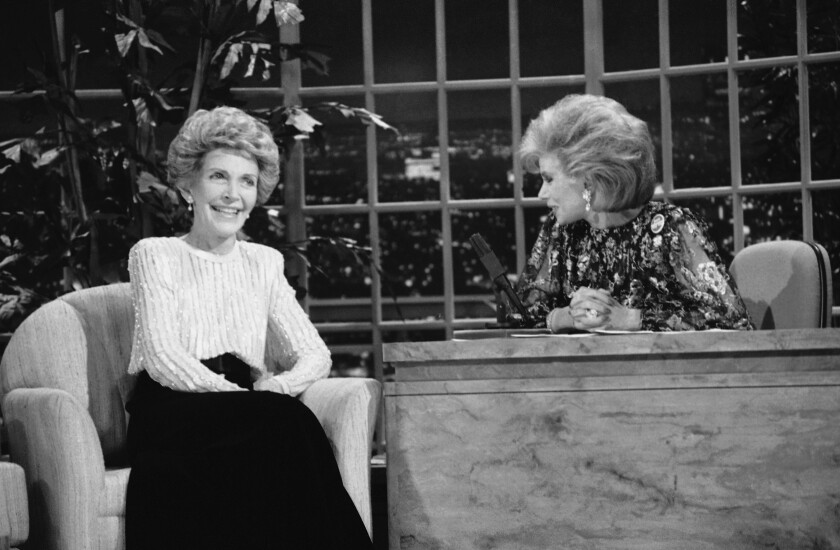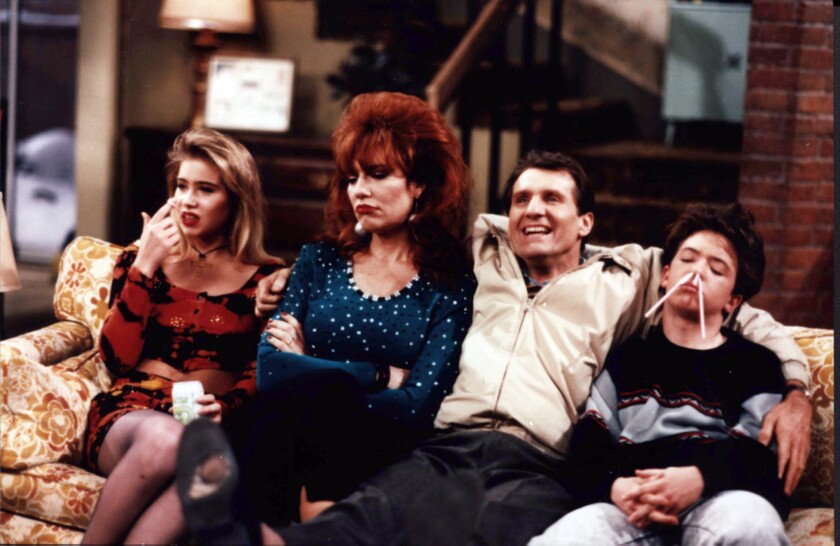Thirty-five years ago this month — after a complicated set of legal maneuvers that involved News Corporation owner Rupert Murdoch renouncing his Australian citizenship and becoming a U.S. citizen so he could buy independent TV station group Metromedia, then paying oil tycoon Marvin Davis $325 million for half the equity in one of Hollywood’s most legendary film studios — a fourth television network premiered in the United States.
Others had previously tried, and failed, to compete against the Big Three broadcasters that had dominated the medium from its infancy: ABC, CBS and NBC. Led by 20th Century Fox chairman and CEO Barry Diller, Fox was met with a mix of schadenfreude and mockery.
“Everybody thought we would fail. We were actually referred to as the ‘wire hanger’ network,” Diller says, referencing a pejorative nickname used by then-NBC programming chief Brandon Tartikoff and others because several Fox stations in smaller markets aired on UHF bands, or antennas with conductors made from metal wiring.
The other issue was the tone of Fox’s programming.

“The Simpsons” was first introduced to TV audiences on “The Tracey Ullman Show.”
(Fox)
Producer and media executive Garth Ancier, who was Fox’s first entertainment president, says that “Barry’s thought process, which I think is correct, is that if you put on the same kind of fare that the big guys put on, you wouldn’t make any progress, because why wouldn’t they just [go] to CBS?”
Shows like “Married … With Children,” “The Simpsons,” “Beverly Hills, 90210” and “In Living Color” would eventually set the network apart from its competitors. They’d also help to dramatically alter the TV landscape, presaging our supersaturation of viewing options and the proliferation of buzzy shows with descriptors like “edgy” and “dramedy.”
Even the network’s name was a signifier of a sea change: “We originally didn’t call it ‘Fox,’” Ancier says. “We called it ‘Fox Broadcasting Company’ because we wanted to have three letters like the other guys.”
“We very quickly realized we should change the name to Fox because it’s a familiar brand from a studio that’s 100 years old, and that is going to trump a made-up name.”

Talk show host Joan Rivers, right, talks with Nancy Reagan during the first lady’s appearance on “The Late Show Starring Joan Rivers” in October 1986.
(Reed Saxon / Associated Press)
Joan-sing for Something Different
On Oct. 9, 1986, Fox began its soft launch with “The Late Show Starring Joan Rivers.” (Coincidentally, Fox News Channel launched the same week 10 years later, on Oct. 7, 1996.) Striking a balance between a fresh start for a new channel and a familiar name — Rivers was known to devotees of rival NBC’s “The Tonight Show Starring Johnny Carson,” where she was a frequent guest host, for her ballsy interviewing tactics — the program garnered plenty of news coverage leading up to its debut (“Can she talk? More to the point, can she survive?” ended a Times story from the era).
Rivers’ departure a few months later, brought on by the tumultuous falling-out that she and her husband-manager, Edgar Rosenberg, one of the show’s producers, had with Diller, is still one of Hollywood’s most sordid stories. (Showtime recently announced “The Comeback Girl,” a miniseries starring Kathryn Hahn that touches on this era of the late comedian’s life.)
In her memoir “Still Talking,” Rivers wrote that “‘The Tonight Show’ was like going to somebody else’s party in a great dress, and now at Fox I had to throw the party myself, night after night, and worry whether everybody had a good time.”
But Morgan Gendel, a television writer-producer and former Times journalist who covered the Fox launch, acknowledges just how forward-thinking it was to put a woman in charge of the network’s first programming.
“They saw an open area they could jump into,” he says. “They didn’t get enough credit for it at the time. People probably looked down their noses.”
Ull-uminating Sketch Show
Even if there was sexism behind the scenes, Fox continued the female-forward theme. In April 1987, the network officially launched, introducing programs like “The Tracey Ullman Show,” a sketch series built around the British-American comedian’s thick Rolodex of characters. (It was also the program that introduced TV audiences to “The Simpsons.”)
Ullman declined to comment for this story, but series co-creator James L. Brooks says he chose to take “Tracey” into the uncharted waters of an upstart network because Diller told him there would be “no censorship.” Specifically, Brooks says, “It was like working experimental theater. When we started the show, we had all these terrible ideas that we had to work out. … And we were allowed because we had a television show that was not subject to quick judgment about whether we could be successful or not.”

Tracey Ullman, left, with Fran Drescher on “The Tracey Ullman Show,” an innovative sketch comedy series, which premiered in 1987.
(Fox)
“We used to say it was a show starring somebody nobody ever heard of on a network that nobody watched,” Brooks laughs.
The show would go on to win 8 Emmys. Looking back, Brooks also thinks of characters like Francesca, who was the teenage daughter of a gay couple and “was so far ahead of its time. I mean, I think it was just amazing that we got to do that.”
“Not the Cosbys”
Then there was “Married … With Children,” the raunchy multicamera family comedy that got zero Emmys in its 11-season run but that Brooks recalls “saved the network.”
“We wanted an alternative [to the Big Three] and we didn’t really know what that alternative was, but we started programming and bouncing off different creative walls as to what to do,” Diller says. “At the time, the biggest comedy on television — the biggest show on television — was ‘The Cosby Show.’ And a pilot script came in that … was known internally for a while as ‘Not the Cosbys,’ because it was ‘Married … With Children.’”

The Bundy family, from left: Christina Applegate as Kelly; Katey Sagal as Peggy; Ed O’Neill as Al; and David Faustino as Bud in “Married … With Children.”
(Fox)
The series, which was created by “The Jeffersons” alums Michael G. Moye and Ron Leavitt, was everything that a sophisticated comedy like “Cosby” was not. Starring Ed O’Neill, Katey Sagal, Christina Applegate and David Faustino as the Bundy family, a foursome who said and did all the wrong things, the show encapsulated “who we are: edgier, younger, willing to go against what was the norm of the moment,” says Diller.
It also caused an attempted boycott by more conservative viewers and advertisers, which backfired as more viewers tuned in to see what all the fuss was about.
Ancier was told that the Bundy parents were loosely based on Leavitt’s own marriage to his first wife, Sharyn — a story he believes, especially after the year he visited their house for Thanksgiving and the meal erupted into a food fight.
He also stresses that not everything he got pitched, and not everything Fox aired, was memorable.
“There was never a show I couldn’t get, [but] I couldn’t get certain writers who really would not work with a fourth network,” Ancier says. “And that’s where you felt like, ‘If I’m getting this show it’s because other people have passed.’”
“The people who were behind ‘Married … With Children’ were probably much lesser known than Jim Brooks or [‘Family Ties’ creator] Gary Goldberg and [‘The Rockford Files’ co-creator] Stephen Cannell, but they were some of the best comedy writers out there,” says Ancier, adding that “they just never had had their moment to shine because they were making shows like ‘The Jeffersons.’”
Outfoxing the Status Quo
It wasn’t just the programming choices that set Fox apart from its rivals. It was the very concept of making original content, prophesying the deals now common at streaming platforms like Netflix.
“I’m sitting on a station group of eight stations, and I got to pay through the nose for programming,” former journalist Gendel explains. “And then suddenly I say, wait a second, let’s turn around, let’s make our own programming. And we’re gonna sell it to all those other independent stations, and we’re getting our programming for free.”
He says it was “brilliant” because “you go from paying a fortune for secondary programming that are the castoffs to creating brand new shows and getting other people to pay for them. And they’re made by your studio.”
But the Fox launch wasn’t an exact model for the present. Now, newer streaming services come prepared to bowl you over with content. Disney+ launched with a slew of original programming, including “Star Wars” series “The Mandalorian.” Apple TV+ came with the star-studded “The Morning Show” and astronaut series “For All Mankind.” HBO Max and Peacock both came stacked with catalogs of beloved programming associated with their brands. (Diller, who coincidentally had been the chairman and CEO of Paramount Pictures before coming to Fox, had hoped to launch with a “Star Trek” series — just like Paramount+ precursor CBS All Access originally planned.)

Keenen and Damon Wayans from “In Living Color.”
(Fox Broadcasting Co.)
And while diversity was (and remains) a problem both in front of and behind the scenes in media — Diller says that his executives were largely young, white men because those were the only hiring options in the 1980s — Fox did make early inroads with shows like sketch series “In Living Color,” which launched in 1990 and mainstreamed the careers of Damon Wayans, Jamie Foxx, Jennifer Lopez and host and creator Keenan Ivory Wayans.
“If you’re going to do a sketch show, you don’t have to be telling great stories. You just have to be good at thinking about blackout sketches,” Ancier says, using the industry term for quick, fast-paced bits. “It’s not like Keenan is [‘Saturday Night Live’ executive producer] Lorne Michaels. He’s a very different kind of human being. And while he was one of the show’s performers, he was, more importantly, the executive producer and writer.”
Content Is King
Fox’s most significant legacy may be in laying the groundwork for TV series that went beyond the formula of popular sitcoms and heroic dramas, offering development executives early evidence of the audiences for more niche fare.
“I think it’s tough to think of creative people as content providers, in a way,” Brooks says.
But I think the heart beats true no matter what. I think more opportunities, more people wanting something different … that creates new things.”
Diller says that he “probably watches seven or eight” streaming channels and that he knew streaming was inevitable once “cable started proliferating with all different subchannels.”

Former chairman and CEO of Paramount Pictures and Fox Barry Diller poses at his residence in Beverly Hills in 1998.
(Michael Tighe / Donaldson Collection / Getty Images)
“I think that until the money runs out, which in many cases it will, people are gonna pour money into streaming on the theory that the only way to succeed is to build scale and be direct to your consumer,” he says.
When asked if he still watches Fox, though, Diller laughs and says no.
“I watch some of FX, which is Fox-owned,” he says. “But Fox broadcasting left me a long time ago.”
Stay connected with us on social media platform for instant update click here to join our Twitter, & Facebook
We are now on Telegram. Click here to join our channel (@TechiUpdate) and stay updated with the latest Technology headlines.
For all the latest Entertainment News Click Here
For the latest news and updates, follow us on Google News.
